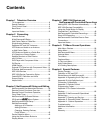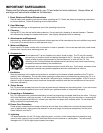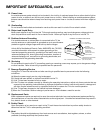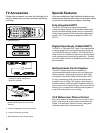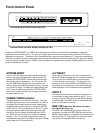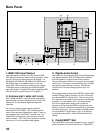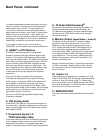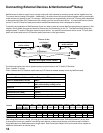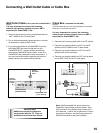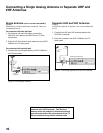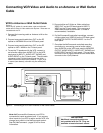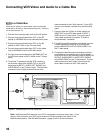10
11
Back Panel, continued
is a nationwide standard system that allows your local
cable TV provider to supply you with an access card
customized to your account. This card allows the
TV to receive, decode and unscramble the premium
digital channels included in your cable TV subscription
without the use of a cable box. It also allows your
cable provider to automatically update and change your
subscription. See pages 15, 25, and 44 for additional
CableCARD information and activation instructions.
If your cable company is not currently offering
CableCARD, you will need to use an external cable box.
5. HDMI™ or DVI Devices
The HDMI™ interface supports uncompressed
standard, enhanced and high definition digital video
formats. This interface also supports existing digital
multi-channel audio formats. The HDMI input supports
both video and audio using one single cable. Use this
input to connect to EIA/CEA-861 compliant devices
such as a high definition receiver or DVD player. This
input supports the 480i, 480p and 1080i video formats.
It is not intended for use with personal computers
or devices outputting video signals with computer
resolutions.
This input can also be used as a DVI connection
with separate analog audio inputs (see DVI Analog
Audio, below). An optional HDMI-to-DVI adaptor will
be necessary to make this connection and can be
purchased from your local electronics retailer. When
using the optional HDMI-to-DVI adapter, the DVI analog
audio inputs on your TV allow you to receive left and
right audio from your DVI device.
This input is HDCP (High-Bandwidth Digital Copy
Protection) compliant.
6. DVI Analog Audio
Unlike HDMI, DVI does not carry audio information on
the same cable. Use these analog stereo audio inputs
when using the HDMI input with a device that outputs
DVI instead of HDMI.
7. Component Inputs 1-2
YPbPr(480i/480p/1080i)
These inputs can be used for the connection of devices
with component video outputs, such as a DVD player,
external HDTV receiver or compatible video game
system. Please see Appendix B for signal compatibility.
8. IR Output-NetCommand
®
Two jacks are provided for connecting IR emitters. IR
Emitters connected to these jacks are used by the
TV’s NetCommand system to control external analog
devices such as VCRs, DVDs, cable boxes, satellite
and audio receivers.
9. Monitor Output (Audio/Video 1, Audio 2)
The Monitor Output sends the TV audio and video
signals from the antennas or Inputs 1-3 to an A/V
Receiver or other analog A/V equipment such as a
VCR. Digital channels and IEEE 1394 signals will be
down converted to analog signals compatible with
traditional analog VCRs. There will be no video signals
from digital channels or IEEE 1394 signals that have
copy restrictions. There will be no video signals from
Monitor Outputs when viewing the Component 1 & 2
inputs or the HDMI input
Monitor Output Audio/Video 1 should be connected to
a VCR for recording. Monitor Output Audio 2 should
be connected to your A/V Receiver for home theater
surround sound.
10. Inputs 1-2
These inputs can be used for the connection of a VCR,
Super VHS (S-VHS) VCR, DVD player, standard satellite
receiver or other A/V device to the TV. Please note
that if you connect to the S-VIDEO terminal, the VIDEO
terminal is deactivated. The VIDEO terminal is available
when there is no S-Video connection.
11. SERVICE PORT
This input is for use by Authorized Mitsubishi Servicers
only.



